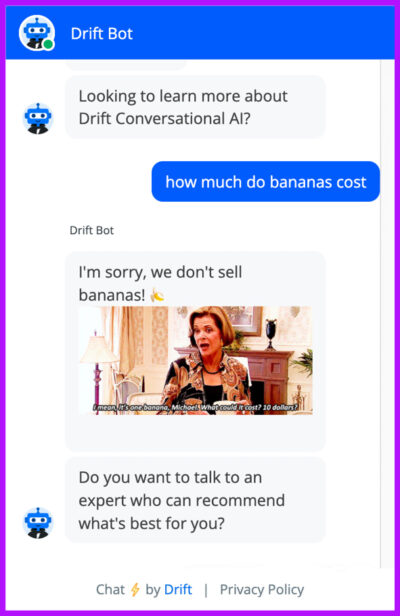Although you probably encounter the term “artificial intelligence” regularly, you may have forgotten what it actually means. In this section, we’ll explain what people are talking about when they refer to AI — including examples you use for fun and work — and dig into Conversational AI specifically.
What Is AI?
Don’t worry; acronyms are weird like that.
Early AI adopter IBM writes: “Artificial intelligence leverages computers and machines to mimic the problem-solving and decision-making capabilities of the human mind.”
Dictionary-writer Merriam-Webster defines artificial intelligence as:
“1: A branch of computer science dealing with the simulation of intelligent behavior in computers.
2: The capability of a machine to imitate intelligent human behavior.”
As you can tell from these definitions, AI has a broad meaning. “AI is an umbrella term that explains a bunch of very distinct technologies,” explains Kyle Bastien, Drift’s VP of Sales Readiness. “But generally, it’s training a machine to recognize patterns, and then do things automatically in response.”
Examples of AI that you likely interact with in daily life include:
- Facial recognition software, e.g. the kind that unlocks your phone
- Short video summaries and recommendations on streaming services
- Spam filters on email inboxes
- Personalized social media feeds
- Personalized ad recommendations
AI Is Already on the Payroll
Many companies are also using tools based on AI internally as business leaders are starting to appreciate AI’s efficiency and speed. For example, customer relationship management (CRM) tools, customer data platforms (CDPs), and accounting software can all benefit from AI that observes and analyzes vast quantities of data and responds appropriately, often across different programs.
AI is also becoming more and more popular with sales and marketing teams. In Drift and Marketing AI Institute’s 2022 State of Marketing and Sales AI Report:
- 51% of respondents predicted that AI will be critical or very important to their marketing success over the next 12 months.
- 41% of respondents predicted that AI will automate half (or more) of their tasks in the next five years.
- The three most common uses of AI in marketing today are large-scale personalization (41%), extracting insights from data (40%), and accelerating revenue (40%).
Clearly, many companies have set their sights on AI and they anticipate it will have a massive impact on businesses for many years to come. The bot take here? If you aren’t planning to put AI on your payroll, you’re going to be missing out.

What Is Conversational AI?
As Kyle explained, AI is a broad term that covers a wide range of technologies.
For example, another popular buzzword, machine learning (ML), is a branch of AI. Entire books can and have been written on the subject — but the one-line version of ML is that bots are told to complete a task, they try over and over, are corrected by another bot or by a human, and use that information to gradually get better at the task.
Conversational AI uses an advanced version of a branch of AI called natural language understanding (NLU). In its most basic form, NLU can recognize keywords around a topic. For example, if someone types in a query that includes the word “price,” “priced,” or “cost,” the AI understands that they want to know about pricing, but not the exact nature of their question.
Common examples of NLU include:
- Automated phone trees
- Predictive text
Conversational AI takes NLU to the next level. It can recognize not just individual words, but the deeper context of queries. Common examples of Conversational AI include:
- Virtual assistants, e.g. Amazon’s Alexa and Apple’s Siri
- Google Search
Google Search is a helpful example of the sophisticated NLU method used in Conversational AI. In 2018, Google switched from keyword searches to a technique called Bidirectional Encoder Representations from Transformers (BERT). Instead of looking at each word in a search query individually, this AI looks for relationships between words in order to build context.
🤖 Fun fact: BERT is estimated to have helped Google better understand 10% of all searches in English.
One way it does this is by identifying words by category, e.g. proper nouns and conjunctions, as this can help determine a word’s role in a query. “It’s a more nuanced way of understanding many different words strung together in a sentence, which is how people communicate when they chat on a website,” Kyle says.
For example, if one user types the question, “There’s a problem with my pricing,” and another types, “Tell me about your pricing,” a basic type of NLU will recognize that they need information about pricing. Depending on its programming, the AI may proceed to send them an identical response. In contrast, Conversational AI that uses a system like BERT can understand the difference between these queries and respond to each person appropriately.
However, that doesn’t mean it’s thinking for itself. The bot is trained on relevant topics by a person. They’re the one who determines how it responds in different circumstances. What makes Conversational AI intelligent is not an ability to formulate answers to questions, but its ability to take unstructured data — like customer phone calls, search queries, or chats — and extract a nuanced meaning from that language. This enables it to then choose the most appropriate response from the presets given to it by human programmers. “That makes it seem like you’re talking to a human, but the AI is just understanding what people mean when they type characters on their keypad,” Kyle says.
Hopefully, this has laid out three foundational aspects of Conversational AI:
- It’s a more sophisticated version of technology you’ve been using for decades.
- It cannot operate effectively without human intervention and oversight.
- It provides more advanced customer conversations than chatbots that rely on keywords or multiple choice.










